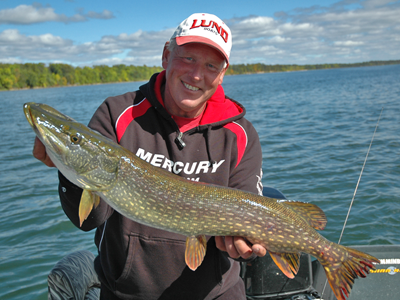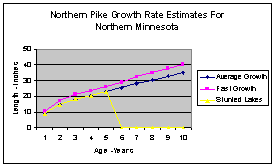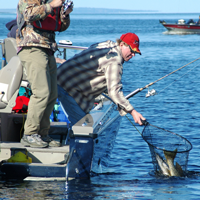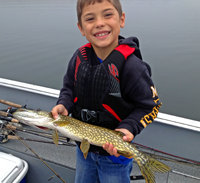
Northern Pike Fishing, The Quest For Quality Size Pike in Minnesota Waters
 Travel with almost any group of anglers in Northern Minnesota and you’re bound to hear some pretty dicey comments that reflect poorly on the present state of Northern Pike fishing in the northland.
Travel with almost any group of anglers in Northern Minnesota and you’re bound to hear some pretty dicey comments that reflect poorly on the present state of Northern Pike fishing in the northland.
All too often, anglers encounter lakes that have enormous populations of stunted Pike where catching a "quality fish" could earn you a lifetime achievement award. Try to swim a lure through these legions of small Pike and it’s easy to see how they would raise the ire of anyone hoping to attract the attention of more worthy combatants.
Snakes, scissors bills, slimes and a host of other even less flattering nicknames get thrown around on nearly every fishing trip I do in the summer. But in my travels as a full time fishing guide, I have seen strange transformations occur whenever someone catches what I’d call a "quality Pike", lets say 5 pounds and up.
No matter how harsh the rhetoric, no matter how bad folks think the small Pike are, a larger specimen is almost always going to bring happiness to the lucky soul that catches it. So in truth, most anglers really like Northern Pike, what they don’t like are stunted Pike that feed like they’re on a suicide mission. The questions are; on lakes where the quality has already slipped, how we can get back to better Pike fishing? And how can we protect g
ood Pike fishing where it still exists?
First, we need to remember that there are Northern Pike lakes and then there are NORTHERN PIKE LAKES. The lakes that produce big pike have the magic combination of cool water, good cover and plenty of food for fish in every size range.
Since growth rates for Pike are largely determined by the fish’s diet, there are certain lakes that just can’t deliver the whole package. In these lakes, trophy Pike will probably never flourish. On the other hand, these lakes can produce large numbers of smaller Pike that provide great action for folks who want eating size fish and for introducing youngsters to the sport.
 There are still lots of lakes in Northern Minnesota that do provide this proper balance. These lakes can and will grow larger Pike. In these lakes, the opportunity for quality fishing depends largely on how we manage the resource.
There are still lots of lakes in Northern Minnesota that do provide this proper balance. These lakes can and will grow larger Pike. In these lakes, the opportunity for quality fishing depends largely on how we manage the resource.
All young Pike start out equal. They are opportunistic feeders that will happily feed on most minnows, crustaceans and almost any small game fish that crosses their path. This "puppy chow" type of forage is generally adequate in most lakes, so combined with an abundance of excellent spawning habitat, the stage is set for the production of lots and lots of young Northern Pike. In lakes with average growth rates, a Pike at age 4 is roughly 20 inches and by age 8 reaches the 30-inch range or about 10 pounds.
The privileged Pike that live in waters with lots of food have faster growth rates and the Pike at age 4 could be closer to 24 inches, while the 8-year-old can be upwards of 35 inches. In Minnesota today, any Pike that reaches age ten is a true old timer and could reach 40 inches or about 20 pounds. Today, these larger fish are near the end of the line and very few Pike grow older than ten years of age.
Stunting, the over-abundance of small fish occurs when one of the key elements is out of balance. Most common in our region are lakes that have an abundance of spawning habitat, but provide too little forage to support the huge number of Pike that these lakes produce.
Before a lake can produce large Pike, the smaller fish must first reach a size where they can begin feeding on the larger forage species. The exact forage could vary from lake to lake, but typically Cisco, large Lake Shiners, Suckers or Whitefish come to mind. The point is that these fish need a "super size" meal to reach quality sizes. If their favorite foods are present, they’ll select those. If not, they’ll try to make do with whatever happens to be available.
Picture what would happen to your waistline if you’d switch to a strictly T-bone and ice cream diet. If the smaller fish don’t have the chance to grow into the larger categories or if the better foods aren’t available, they get forced into feeding on the smaller forage species, moving constantly in an effort to get enough to eat. It’s enough to keep them alive for a while, but after a few years, even the small Pike begin to die of "old age". This live fast, die fast cycle is literally akin to "eating themselves to death".
 Another roadblock in the search for quality Northern Pike is this fishes tendency to be it’s own worst enemy. At times, they’re just too easy to catch! Large Pike feed heavily making them an easy target for hungry anglers who are in turn, all too happy to remove them from their favorite lake. Over time, these larger Pike are over-harvested and the remaining smaller pike compete heavily for food and never attain adequate size required to help move them into the next feeding stage. So even "good lakes" can become over-populated with these stunted Pike.
Another roadblock in the search for quality Northern Pike is this fishes tendency to be it’s own worst enemy. At times, they’re just too easy to catch! Large Pike feed heavily making them an easy target for hungry anglers who are in turn, all too happy to remove them from their favorite lake. Over time, these larger Pike are over-harvested and the remaining smaller pike compete heavily for food and never attain adequate size required to help move them into the next feeding stage. So even "good lakes" can become over-populated with these stunted Pike.
In the end, all too many folks go away with the impression that Pike fishing is just a waste of time. It’s a never-ending downward spiral and unfortunately, a lot of the trouble is our own fault.
You see, in most lakes, Pike are seated firmly at the top of the food chain, so it’s only us (anglers) who have ever removed these larger fish. Because of their aggressive feeding habits, the very presence of these larger Pike could have helped to remove smaller fish from the system. In turn, that would help reduce competition for food and increase the likelihood of more Pike reaching desirable size.
From a fisherman’s point of view, what needs to happen is that more anglers need to value and keep smaller fish for eating. At the same time, we (anglers) need to recognize the importance of returning medium size Pike to our lakes.
In a nutshell, the exact fish that most of us have found acceptable as "eating size fish", are the ones that need protection the most. Once these fish reach this critical stage, growth rates can be phenomenal and an angler who is willing to release a 5-pound fish today, could easily be trading for a chance to catch a 15 pounder in just a few years. In terms of the health of your favorite Pike fishery, it would probably be far better to remove lots of the smaller fish and some of the largest fish.
 Over the past few years, I’ve been on a mission to get folks more interested in using the smaller Pike to satisfy the urge for a fish dinner. Most folks are easily converted to my way of thinking when they experience first hand, some of the really great dishes that can be made utilizing this plentiful supply. Creative management of the fishery should include higher bag limits of these smaller fish for folks who enjoy them. Protected slot sizes or reduced bag limits of the medium size Pike would help keep these fish in the system to grow and help control over-population.
Over the past few years, I’ve been on a mission to get folks more interested in using the smaller Pike to satisfy the urge for a fish dinner. Most folks are easily converted to my way of thinking when they experience first hand, some of the really great dishes that can be made utilizing this plentiful supply. Creative management of the fishery should include higher bag limits of these smaller fish for folks who enjoy them. Protected slot sizes or reduced bag limits of the medium size Pike would help keep these fish in the system to grow and help control over-population.
Deserving at least a mention, the health of the forage base itself is an area we need to watch. A variety of water quality concerns and a period of warmer than usual fall spawning seasons have already affected populations of Tulibee in particular. There are already lakes in Minnesota’s prime Northern Pike range where the cool water species like Tulibees are existing on the edge of the lakes ability to support them. So far, water quality hasn’t shown up on the radar screen of most anglers, but if it affects the food chain, it’s going to reach the average fisherman eventually.
It’s kind of self-serving to say that we need more opportunities for quality Pike fishing. But, take a look at Minnesota fishing history and then check your map. Given the habitat, we should be among the top destinations in the world for great Pike fishing. Whether your interest is tourism, family sport fishing or food on the table, how can better fishing in Minnesota be bad?
Join US On Facebook and Become A Duly Deputized Fishrapper Cub Reporter
 Helping your fellow fishermen and women stay abreast of fishing conditions in your area is good for everybody and it's easier than you think!
Helping your fellow fishermen and women stay abreast of fishing conditions in your area is good for everybody and it's easier than you think!
You don't have to write a book, you don't have to share your secret fishing spots and you don't even have to mention your lake. But even a few words about general trends, seasonal patterns and local weather conditions can really help.
Fishing Reports Minnesota, the Facebook counterpart to this page is open to the public, so you can post your own fishing update or just share a photo of a nice catch. Be like me, become a duly deputized "Cub Reporter", it's good for fishing! Contact Us
Home | Current Fishing Report | Saved Fishing Reports | Favorite Lakes | Fishing Articles Section | Recipes | Rates Services | Gift Certificates | Contact | For Sale | Links | Sitemap |
"The Early Bird Fishing Guide" Jeff Sundin - Fishing Blue Books, LLC 715 Byington Ave, LaPrairie, MN 55744 218-245-9858
Email copyright©2018 Fishing Blue Books, LLC All Rights Reserved - last revised 1-12-18